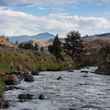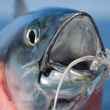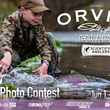Over the last decade or so, the fly fishing community's perception of carp has changed dramatically. Carp, which was not long ago widely seen as a species of "trash fish" only chased by fishermen wielding spinning rods with mish-mashed balls of corn meal and table scraps tied to the end of their line has reached fairly wide acceptance as one of the finest game fish available to anglers. Add in the fact that carp are more widely distributed across the US and the globe than perhaps any other species of game fish, offering a gross abundance of angling opportunities, and it is easy to understand why so many anglers are looking to get started chasing carp.
But where to start? Especially for the trout fisherman, pursuing carp is considerably different than heading out in search of the normal quarry. Fishing for carp is much more akin to fishing for bonefish and other flats species (which has fairly earned carp the nickname "freshwater bonefish"), so if you are accustomed to that kind of fishing you are going to be more prepared for chasing carp. Carp, in fact, can be radically different from trout in and it is important to understand the differences if you intend to target them, as applying tactics that you have learned while trout fishing typically won’t work well and will often lead to poor results.
Carp Feed Differently
Most of the time, carp feed in a very different manner than trout do. They are often pointed at the bottom rather than looking up. This means that you typically need to have your fly right on the bottom and not moving or moving very slowly. Most of the time carp won’t move far for a fly.
Carp are Spookier
They are spookier too, so little sounds can have a huge impact on them. Wade very softly and minimize boat noise. Scents can also spook carp. Be sure to wash your hands if you handle sunscreen or work on motor or something similar before handling the fly. Even fly line color should be considered. Brightly colored lines can spook carp easily.
Carp are More Subtle
Another big difference from stream fishing for trout and fishing for carp is that you really need to keep the rod tip low and close to the water. A carp will take a fly very subtly and if you have any slack in your line they will spit it out before you've noticed what has happened. Keep your rod tip low and keep a tight line on it. If a carp takes then your fly, it will often hook itself. It is also important to avoid hard or aggressive hook sets. Carp are a lot bigger than most trout and if you set the hook hard you will likely break it right off. A strip strike or just raising the rod will do it nicely. Carp have a pretty soft mouth that a hook gets into easily.
Carp are Bigger. Carp are Stronger.
Carp tend to be a lot bigger and fight harder and longer than trout. Check your gear. Watch your knots. Be ready to work that fish once you hook it. Plan on using a heavier rod than most trout fishing -- a 6 to 8 weight is usually about right. It pays do double check everything so that you land a fish once you hook it. Also, bring a big rubber net to help land it.
Carp Fishing is More Visual
One thing that makes carp fishing a lot of fun is that it is typically a visual game. You are looking for fish and casting to them. That can be very different than a lot of trout fishing -- whether nymphing, streamer fishing or trying to elicit rises with stimulators and other attractor dries -- where you blind cast. Blind casting to carp usually is not productive; often what seems to happen is that a non target species like a bass or perch grabs the fly just as a nice carp comes into view.
Targeting carp will undoubtedly require patience from the trout angler, but the more time on the water you spend chasing carp the better your skills will become. Each outing will afford new opportunities to explore and learn about the carp's environment. The odds will get better, you'll find success more often and you will undoubtedly have a blast chasing the freshwater bonefish.
Understanding the differences between trout and carp is the first step in upping your chances for success when on the water pursuing carp, but there's more. A lot more. Check back later this week for >4 More Tips for the Beginner Carp Fisherman.
Drew Price is a Vermont fly fishing guide and self proclaimed "fish geek", chasing trout in Vermont's streams and all manner of beasts on the preposterously fishy Lake Champlain. Learn more about Drew at www.drewpriceonthefly.com
.
































Comments
Raymond Anthony Montoya replied on Permalink
Great crap advice with one exception. While generally true that carp are primarily taken on damsel fly patters, and bead heads, we have taken a shit load of carp on terrestrial patterns-ants, beetles and hoppers. When the wind kicks up, we fish lake banks facing directly into the wind. That's where the carp are feeding on the scum line. I've also raised cruising carp on clear calm mornings with small ant patterns. They are indeed spooky, but they are also opportunistic. Give them a good lead and when they get close, just a slight twitch. Anyone who has chased bonefish or permit will really appreciate carp. It's such a visual experience, but like permit, they are extremely wary. Unlike perms, once you got it figured out, you can get them to eat consistently. Ill take carp any day over trout.
Pages